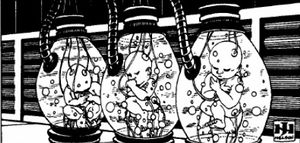Difference between revisions of "Iron Womb"
LittleWolf (talk | contribs) |
CungrVanck (talk | contribs) (Added info from Wolf Clan Sourcebook) |
||
| (One intermediate revision by one other user not shown) | |||
| Line 3: | Line 3: | ||
'''Iron Wombs''' are artificial birthing chambers used by the [[Clans]] as part of their eugenics program for the creation of the perfect [[trueborn]] warriors. Early examples were first used in [[2816]] to birth the first Clan warriors, but by [[2819]] dedicated "birthing systems" had been developed, with the devices evolving steadily over the years until the current model was developed by [[Clan Diamond Shark]] in [[2850]].<ref name="TC:WoKp68">''The Clans: Warriors of Kerensky'', p. 68, "Medical Technology And Genetics"</ref> | '''Iron Wombs''' are artificial birthing chambers used by the [[Clans]] as part of their eugenics program for the creation of the perfect [[trueborn]] warriors. Early examples were first used in [[2816]] to birth the first Clan warriors, but by [[2819]] dedicated "birthing systems" had been developed, with the devices evolving steadily over the years until the current model was developed by [[Clan Diamond Shark]] in [[2850]].<ref name="TC:WoKp68">''The Clans: Warriors of Kerensky'', p. 68, "Medical Technology And Genetics"</ref> | ||
| − | However the technology for iron wombs dates back to the late [[Twentieth century|twentieth]]/early [[twenty-first century|twenty-first]] centuries, when the Jutendo University on [[Terra]] created life-support systems for premature babies. These artificial wombs were restricted to their original limited use out of concerns for the moral and social implications of their widespread use. In forming the Clans however [[Nicholas Kerensky]] needed to quickly increase his population, and so such ethical restrictions were abandoned.<ref name="TC:WoKp68"/> | + | However, the technology for iron wombs dates back to the late [[Twentieth century|twentieth]]/early [[twenty-first century|twenty-first]] centuries, when the [[Jutendo University]] on [[Terra]] created life-support systems for premature babies. These artificial wombs were restricted to their original limited use out of concerns for the moral and social implications of their widespread use. In forming the Clans, however, [[Nicholas Kerensky]] needed to quickly increase his population, and so such ethical restrictions were abandoned.<ref name="TC:WoKp68"/> |
| + | |||
| + | Another term for the Iron Wombs is ''canister''. It is a slang term often used by the Clans.<ref name="WCSp124">''Wolf Clan Sourcebook'', p. 124: "Glossary"</ref> | ||
== References == | == References == | ||
| Line 10: | Line 12: | ||
== Bibliography == | == Bibliography == | ||
* ''[[The Clans: Warriors of Kerensky]]'' | * ''[[The Clans: Warriors of Kerensky]]'' | ||
| + | * ''[[Wolf Clan Sourcebook]]'' | ||
[[Category:Clan Terms|Iron Womb]] | [[Category:Clan Terms|Iron Womb]] | ||
[[Category:Technology|Iron Womb]] | [[Category:Technology|Iron Womb]] | ||
Latest revision as of 09:39, 24 March 2023
Description[edit]
Iron Wombs are artificial birthing chambers used by the Clans as part of their eugenics program for the creation of the perfect trueborn warriors. Early examples were first used in 2816 to birth the first Clan warriors, but by 2819 dedicated "birthing systems" had been developed, with the devices evolving steadily over the years until the current model was developed by Clan Diamond Shark in 2850.[1]
However, the technology for iron wombs dates back to the late twentieth/early twenty-first centuries, when the Jutendo University on Terra created life-support systems for premature babies. These artificial wombs were restricted to their original limited use out of concerns for the moral and social implications of their widespread use. In forming the Clans, however, Nicholas Kerensky needed to quickly increase his population, and so such ethical restrictions were abandoned.[1]
Another term for the Iron Wombs is canister. It is a slang term often used by the Clans.[2]



